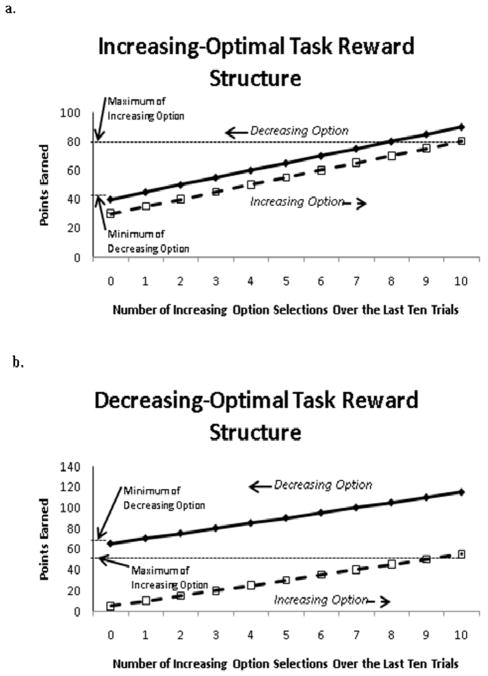Abstract
In two experiments younger and older adults performed decision-making tasks where reward values available were either independent or dependent of the previous sequence of choices made. The choice independent task involved learning and exploiting the options that gave the highest rewards on each trial. In this task the stability of the expected rewards for each option was not influenced by the choices participants made. The choice-dependent task involved learning how each choice influenced the rewards available for both options on future trials and making the best decisions based on that knowledge. Younger adults performed better when rewards were choice-independent, while older adults performed better when rewards were choice-dependent. This suggests a fundamental difference in the way in which younger and older adults approach decision-making situations. We discuss the results within the context of prominent decision-making theories, and offer possible explanations based on neurobiological and behavioral changes associated with aging.
Decisions are a pervasive part of our lives. The importance and impact of our decisions may only increase with age. Older adults often continue to work in prominent positions, and face numerous important decisions such as which retirement options to select, how to spend their life-savings, and how to best live out the remaining years of life. Likewise, younger adults must choose which career path to take, which college to attend, and when to buy a house. It is thus critical to understand how age affects decision-making strategies.
Decisions rarely stand alone. Often the rewards available from each option depend on previous choices. The current job prospects or retirement investments available are dependent on the current state that one has reached. One cannot apply for various teaching jobs if one did not first decide to attend college. Likewise, one cannot decide where to buy a retirement home if one did not first take steps to ensure a productive career that allowed adequate accumulation of retirement savings. Thus, in many real world contexts our present choices often determine our future possibilities.
However, many previous studies that have examined how age affects decision-making have focused on performance in tasks where the rewards available on a given trial are independent of the sequence of previous choices. For example, the probabilities of obtaining rewards of varying amounts on any given trial are often pre-determined by the experimenter and do not change based on what decisions the participant makes. This is true for tasks like the Iowa Gambling task (Denburg et al., 2005), the Behavioral Investment Allocation Strategy task (Kuhnen & Knutson, 2005; Samanez-Larkin, Kuhnen, Yoo, and Knutson, 2010), the Monetary Incentive Delay task (Samanez-Larkin, Hollon, Carstensen, & Knutson, 2007), and the Probabilistic Object Reversal Task (Mell, Heekeren, Marschner, Wartenburger, Villringer, & Reisches, 2009; Mell, Heekeren, Marschner, Wartenburger, Villringer, & Reisches, 2005). A common finding in these tasks is poorer or, at a minimum, equivalent performance for older adults compared to younger adults.
However, one should ponder why older adults, who have a vast reserve of decision-making experience to draw upon, often perform worse, and rarely perform better than younger adults in decision-making tasks (Peters, Hess, Vastfjall, & Auman, 2007; Agarwal, Driscoll, Gabaix, & Laibson, in press). It may be the case that age-based neural declines are so great in older adults that their advantage in decision-making experience, relative to younger adults, cannot be compensated for. An alternative possibility is that the tasks often used to assess age-based effects on decision-making are biased toward the strengths of younger adults (Henninger, Madden, & Huettel, 2010), and older adults’ abilities may be better suited for situations that require higher-order processing of relational dependencies between the sequence of recent choices and the rewards currently available in the environment (Grossman, Na, Varnum, Park, Kitayama, & Nisbett, 2010; Blanchard-Fields, 2007). These situations, where reward values are choice-dependent, may have greater ecological validity in that the options available to us usually depend on the choices we have made previously.
Recently, a distinction has emerged in the decision-making literature between model-based and model-free reinforcement learning systems (Glascher, Daw, Dayan, & O’Doherty, 2010). The model-based system learns a cognitive map of the environment that describes how different options and their associated rewards are connected to one another. The system makes decisions by mentally simulating how one decision will possibly impact future decisions similar to how a chess player decides the best move based on how it will affect future possibilities. In contrast, the model-free system learns the values associated with each choice directly without building an explicit model of the environment.
These systems are neurally dissociable. The model-based system is mediated by areas such as the intraparietal sulcus and lateral prefrontal cortex, while the model-free system is mediated by the ventral striatum (Glascher et al., 2010). Interestingly, a recent study found that younger adults recruit the ventral striatum more than older adults after reward expectancies have been learned, while older adults recruit the dorsolateral prefrontal cortex more than younger adults (Mell et al., 2009). One reasonable proposition stemming from this work is that increases in age are associated with a shift in the neural areas that are recruited for decision-making purposes (Park & Reuter-Lorenz, 2009; Cabeza, Anderson, Locantore, & McIntosh, 2002; Phillips & Andres, 2010). Older adults may recruit more frontal areas, and make decisions in a more model-based manner, while younger adults may rely on striatal areas and engage in more model-free decision-making.
The two systems may be better-suited for solving tasks based on whether the rewards are choice-independent or choice-dependent. Younger adults may make better decisions when rewards are choice-independent, where the rewards available are not influenced by previous choices made, whereas older adults may make better decisions when rewards are choice-dependent, where the rewards available are a function of the previous choices made. Of course one could also predict that neural declines in prefrontal areas (West, 1996) will cause older adults to perform worse on choice-dependent tasks which require identification of the higher order relationship between choices and available future reward values.
We test our hypothesis that older adults engage in more model-based decision-making in two experiments where older and younger adults perform either choice-dependent or choice-independent tasks. In Experiment 1 participants perform a choice independent task where the reward values available for each option are arbitrarily based on the trial number and are not impacted by previous behavior. In Experiment 2 participants perform one of two versions of a choice dependent task. In this task the rewards available for each option are dependent on the number of times one option, the Increasing option, has been selected over the previous ten trials. As its name implies, the Increasing option causes the reward values for both options to increase on future trials. However, the other option, the Decreasing option, gives a higher reward than the Increasing option on any given trial, but selecting this option causes the rewards for both options to decrease on future trials. Thus the choice-dependent task involves learning the trade-off between the short-term benefits of the Decreasing option and the long-term benefits of the Increasing option, whereas no such trade-off must be learned in the choice-independent task.
Experiment 1
Participants completed a decision-making task where the best strategy was to select the option that gave the highest reward on each trial. The rewards given on each trial are shown in Figure 1. There were a total of four options that participants selected from on each of 80 trials. Two options, the ‘A’ decks, gave the same reward on each trial, and the other two options, the ‘B’ decks, gave the same reward on each trial. The B decks gave higher rewards during the first 50 trials. After 50 trials there was an arbitrary (choice-independent) switch and the ‘A’ decks gave the highest rewards on each trial.
Figure 1.
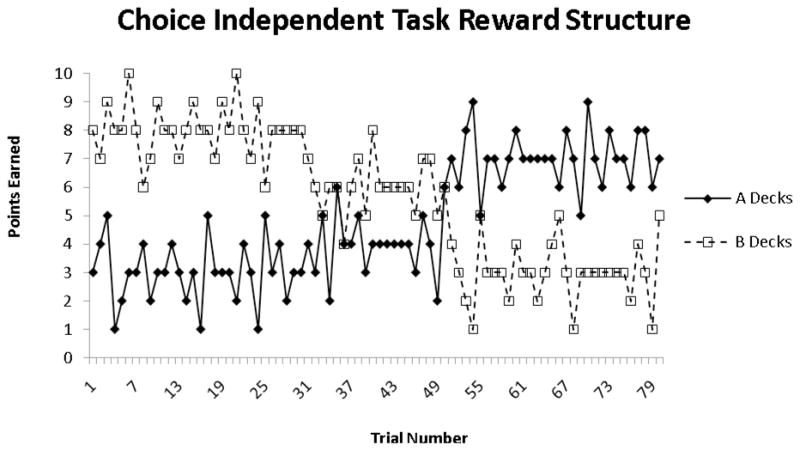
Rewards given for each deck during Experiment 1. Rewards were choice independent in that they were based only on the trial number, and did not change based on the choices participants made. There were four decks, two ‘A’ decks and two ‘B’ decks that were yoked so they gave the same reward on any given trial.
Methods
Participants
28 older adults (60–84 years of age M=68.55; 10 male and 18 female; Mean education = 17.28 years) from the greater Austin community, and 28 Younger adults (18–23 years of age, M=20.29; 9 male and 19 female; Mean education = 15.34 years) from the University of Texas community were paid $10 per hour for participating. Older adults were administered an extensive neuropsychological testing battery to determine any mental declines not due to normal aging (see Supplementary material)1.
Materials and Procedure
The experiment was performed on a PC using Matlab software. Participants were told that they would select from one of four decks of cards on each trial, and that they would receive between 1 and 10 points for each selection. The decks used in this experiment were a four-deck version of a task used in a previous paper from our lab (Worthy, Maddox, & Markman, 2007, Experiment 2). The reward structure was modified from a two-deck to a four-deck version by adding one of each type of deck. Participants were given a goal to try to earn at least 550 points by the end of the experiment (See supplementary material for full instructions). They were told nothing about the rewards associated with each option. To reach this goal, participants had to select the best option on about 90% of trials.
Results
Figure 2 shows the average points earned for participants in each condition. We conducted an independent samples t-test for points earned by younger and older adults. Younger adults (M=522, SD=22.50) earned significantly more points than older adults (M=506, SD=31.60), t(54)= −2.17, p<.05.
Figure 2.
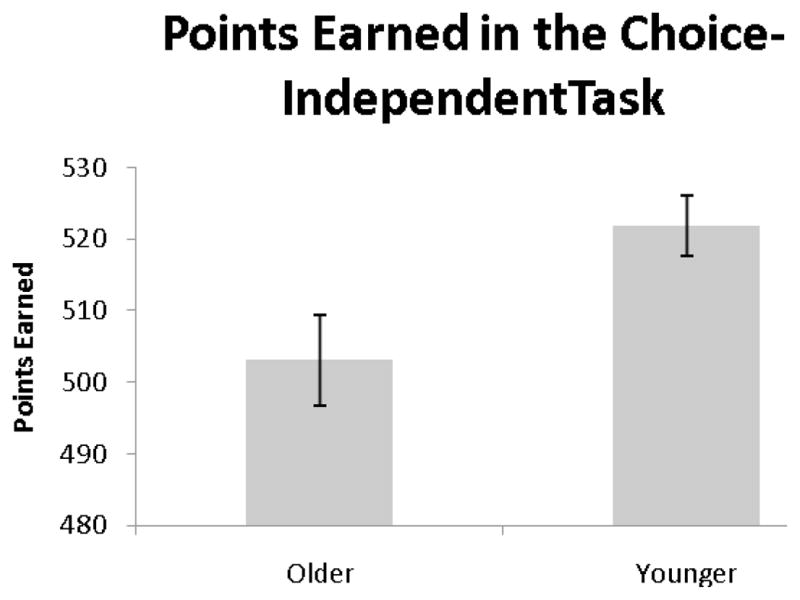
Total points earned in the choice independent task of Experiment 1. Error bars represent 95% confidence intervals.
Discussion
The results support part of our hypothesis that younger adults will outperform older adults on choice-independent tasks. To test the other half of our hypothesis, that older adults will outperform younger adults on choice-dependent tasks, we had younger and older adults perform two variants of a choice-dependent task in Experiment 2.
Experiment 2
Participants performed one of two variants of a dynamic decision-making task where reward values are dependent on the sequence of previous choices. (Gureckis & Love, 2009; Bogacz, McClure, Li, Cohen, & Montague, 2007; Otto, Gureckis, Markman, & Love, 2009). Figure 3 shows reward structures for each task. There are two options, a Decreasing option and an Increasing option. The Decreasing option gives a higher reward on any given trial; however, the rewards available for both increase as the Increasing option is chosen more frequently. Selecting the Increasing option moves participants to the right on the x-axes in Figure 3 (rewards increase), whereas the opposite is true for the Decreasing option (rewards decrease). Reward values for both options thus depend on how often each option has been chosen recently. This is the key difference from Experiment 1.
Figure 3.
Rewards given for each task as a function of the number of the number of Increasing option selections over the previous ten trials. Participants had to juxtapose the short-term benefit of selecting the Decreasing option with the long-term benefit of selecting the Increasing option, and then choose the reward that was optimal for the task. (a.) Rewards given for the Increasing-optimal task. Selecting the Increasing option 10 consecutive times will lead to a reward of 80 points on each trial, whereas selecting the Decreasing option 10 consecutive times will lead to a reward of 40 points on each trial. (b.) Rewards given for the Decreasing-optimal task. Selecting the Decreasing option 10 consecutive times will lead to a reward of 65 points on each trial, whereas selecting the Increasing option 10 consecutive times will lead to a reward of 55 points on each trial.
We vary the optimal strategy between the two versions of the task. Figure 3a shows the reward structure for the Increasing-optimal task. The Increasing option is the optimal choice on each trial because repeatedly selecting it will allow participants to gain the greatest reward for the Increasing option (80 points), while repeatedly selecting the Decreasing option will lead to a much smaller reward (40 points). Figure 3b shows the reward structure for the Decreasing-optimal task. Here the Decreasing option gives a much larger reward. In this case the gain from repeatedly selecting the Increasing option cannot make up the difference. To solve each of these tasks participants must gain an understanding of the underlying reward structure in the environment.
Methods
Participants
52 older adults (Average age = 67.51; Range = 60–82) and 51 younger adults (Average age = 20.35; Range = 18–26) participated in the experiment for monetary compensation. We used the same neuropsychological testing procedure from Experiment 1 (see Supplementary Material).
Materials and Procedure
Participants were given a hypothetical scenario where they would be testing two oxygen extraction systems on Mars.2 Figure 4 shows a sample screenshot from the experiment. Participants were told that they would repeatedly test one of the two systems (A or B) and a bar, representing a small oxygen tank, would show the amount of oxygen they had just extracted. The oxygen would then be moved into the larger tank and the next trial would begin. A line on the larger tank corresponded to the amount of oxygen needed to sustain life on Mars. Participants were given the goal of trying to collect this amount of oxygen over the course of the experiment. The goal lines were set at the equivalent of 16,000 points for the Increasing-optimal task and 13,000 points for the Decreasing-optimal task. This corresponded to selecting the optimal choice in each task on roughly 80% of trials. Participants performed a total of 250 trials. They were told nothing about the rewards available for each option or the choice-dependent structure of the rewards.
Figure 4.
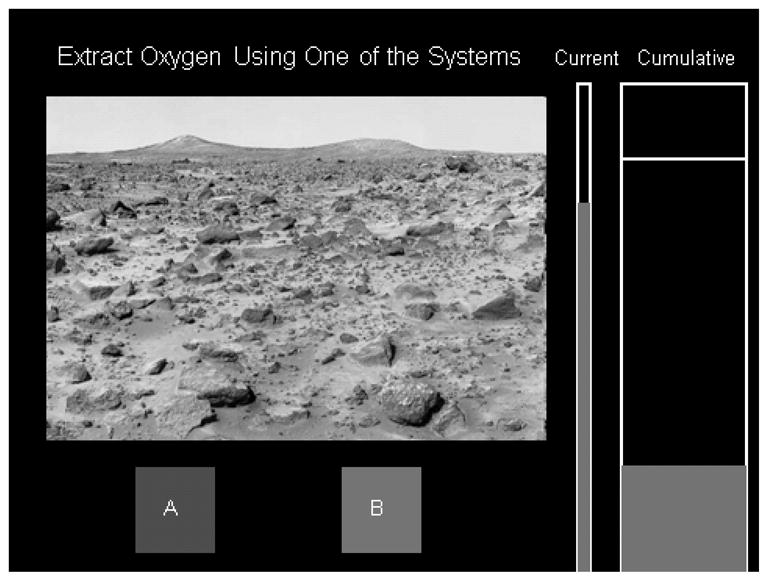
Sample screen shot from the experiment. Participants were given a cover story where they were asked to test two oxygen-extraction systems on the Martian landscape. The oxygen extracted on each trial was shown in the “Current” tank and then transferred to the “Cumulative” tank.
Results
We first examined the proportion of Increasing option selections in each block (Figure 5a). We conducted a 2 (Age) X 2 (Task-Type) X 5 (Block) repeated measures ANOVA on the number of Increasing options selected in the experiment. There was a significant Age X Task-Type Interaction, F(1,100)=8.08, p<.01, η2=.18. There was also a significant main effect of block, F(4)=9,02, p<.001, η2=.08, and Task-Type, F(1,100)=21.56, p<.001, η2=.18. The Block X Task-Type interaction was also significant, F(4,97)=7.89, p<.001, η2=.07. We conducted pair-wise comparisons within each age group to examine the locus of the Age X Task-Type interaction. Older adults selected the Increasing option significantly more often when performing the Increasing-optimal task (M=.56)3 than when performing the Decreasing-optimal task (M=.24), F(1,51)=40.82, p<.001, η2=.45. However, there was no statistical difference in the proportion of increasing option selections for younger adults between the two tasks (Increasing-optimal task M=.48; Decreasing-optimal task M=.40), F(1,49)=1.21, p>.10. Thus, older adults’ performance was more consistent with the optimal strategy across both tasks.
Figure 5.
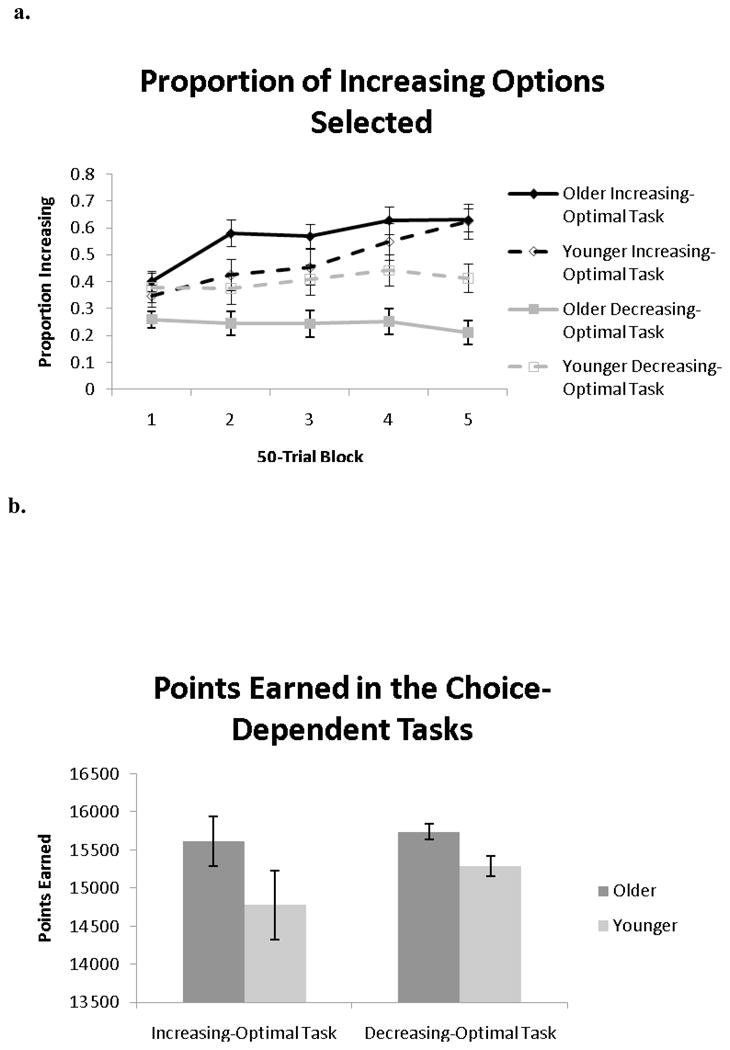
(a.) Proportion of Increasing option selections for participants in each age-task-variant group. Selecting the Increasing option led to a larger cumulative gain in points in the Increasing-Optimal task, while selecting the Decreasing option led to a larger cumulative gain in points in the Decreasing optimal task. (b.) Total points earned for participants in each age-task-variant group. Error bars represent 95% confidence intervals.
We next conducted a 2 (Age) X 2 (Task-Type) ANOVA on the total number of points earned throughout the experiment (Figure 5b). There was a significant effect of Age, F(1,100)=4.80, p<.05, η2=.05. Older adults earned more points than younger adults on both the Increasing-optimal task (Older M=15,614.26; Younger M=14,776.60) and the Decreasing-optimal task (Older M=15,738.46; Younger M=15,286.15).
General Discussion
Previous research suggests an age-related deficit in decision-making, whereas Experiment 2 of the current study suggests an age-related advantage. This discrepancy appears to be due to differences in the choice-reward contingencies, with previous research, and our first Experiment, often focusing on choice-independent conditions (Denburg et al., 2005; Mell et al., 2009), and Experiment 2 of the current study focusing on choice-dependent-conditions. Optimal performance in Experiment 2 required holistic learning of the reward structure rather than simple computation of relative reward values for each option, as in Experiment 1. We interpret these findings as evidence for fundamentally different approaches to decision-making problems between older and younger adults. Older adults likely performed best because they developed specific hypotheses about how rewards in the environment were structured. This allowed them to adaptively respond to the reward environment and to appropriately weigh the strengths and weaknesses of each option. In contrast, younger adults likely performed best in Experiment 1 because they were more efficient in identifying the choices that gave the highest rewards, but performed worse in Experiment 2 because they were slower to develop specific hypotheses about how rewards in the environment were structured. The fact that the proportion of increasing option selections in Experiment 2 was strongly affected by the reward structure for older adults but not for younger adults supports this hypothesis.
This work supports the neural scaffolding hypothesis of aging (Park et al., 2009; Phillips & Andres, 2010) in that older adults appear to have engaged in more frontally mediated, model-based decision-making, while younger adults showed more evidence of striatally mediated, model-free decision-making. In real-world situations it is likely more common that the rewards available depend on previous choices made, similar to Experiment 2. The advantage found for older adults in this experiment may have been partially due to age-based expertise in decision-making situations where current decisions will impact future possible outcomes (Masunga & Horn, 2001). While aging may lead to some cognitive declines, it may also lead to gains in the insight and wisdom used to make the best decisions.
Supplementary Material
Acknowledgments
This research was supported by NIMH grant MH077708 to WTM. We thank Tanya Chotibut, Bo Zhu, Brittany Nix, Devon Greer and other members of the Maddox Lab for their help with data collection, and A. Ross Otto for valuable comments.
Footnotes
We did not observe any significant correlations between neuropsychological test scores and performance measures in Experiment 1. However, for Experiment 2 we found that fewer errors and perseverative errors on the WCST were associated with more points earned in the task (see Supplementary Material).
We use a different decision-making scenario from Experiment 1 because we wanted to follow the procedure used previously for each task (e.g. Worthy et al., 2007 for Experiment 1; Otto et al., 2009). While it is possible that the different scenarios affected behavior in younger or older adults, we feel that the differences in the structure of the rewards had a much bigger impact on decision-making behavior.
Means are collapsed across all blocks.
References
- Agarwal S, Driscoll JC, Gabaix X, Laibson D. The age of reason: Financial decisions over the life-cycle and implications for regulation. Brookings Papers on Economic Activity. 2009;2:51–117. [Google Scholar]
- Backman L, Nyberg L, Lindenberger U, Li SC, Farde L. The correlative triad among aging, dopamine, and cognition: Current status and future prospects. Neuroscience and Biobehavioral Reviews. 2006;30:791–807. doi: 10.1016/j.neubiorev.2006.06.005. [DOI] [PubMed] [Google Scholar]
- Blanchard-Fields F. Everyday problem solving and emotion: An Adult Developmental Perspective. Current Directions in Psychological Science. 2007;16:26–31. [Google Scholar]
- Bogacz R, McClure SM, Li J, Cohen JD, Montague PR. Short-term memory traces for action bias in human reinforcement learning. Brain Research. 2007;1153:111–121. doi: 10.1016/j.brainres.2007.03.057. [DOI] [PubMed] [Google Scholar]
- Cabeza R, Anderson ND, Locantore JK, McIntosh AR. Aging gracefully: Compensatory brain activity in high-performing older adults. NeuroImage. 2002;17:1394–1402. doi: 10.1006/nimg.2002.1280. [DOI] [PubMed] [Google Scholar]
- Daw ND, O’Doherty JP, Dayan P, Seymour B, Dolan RJ. Cortical substrates for exploratory decisions in humans. Nature. 2006;441:876–879. doi: 10.1038/nature04766. [DOI] [PMC free article] [PubMed] [Google Scholar]
- Denburg NL, Tranel D, Bechara A. The ability to decide advantageously declines prematurely in some normal older persons. Neuropsychologia. 2005;43:1099–1106. doi: 10.1016/j.neuropsychologia.2004.09.012. [DOI] [PubMed] [Google Scholar]
- Glascher J, Daw N, Dayan P, O’Doherty JP. States versus rewards: Dissociable neural prediction error signals underlying model-based and model-free reinforcement learning. Neuron. 2010;66:585–595. doi: 10.1016/j.neuron.2010.04.016. [DOI] [PMC free article] [PubMed] [Google Scholar]
- Grossman I, Na J, Varnum ME, Park DC, Kitayama S, Nisbett RE. Reasoning about social conflicts improves into old age. Proceedings of the National Academy of Sciences. 2010;107:7246–7250. doi: 10.1073/pnas.1001715107. [DOI] [PMC free article] [PubMed] [Google Scholar]
- Gureckis TM, Love BC. Short-term gains, long-term pains: How cues about state aid learning in dynamic environments. Cognition. 2009;113:293–313. doi: 10.1016/j.cognition.2009.03.013. [DOI] [PMC free article] [PubMed] [Google Scholar]
- Henninger DE, Madden DJ, Huettel SA. Processing speed and memory mediate age-related differences in decision-making. Psychology and Aging. 2010;25:262–270. doi: 10.1037/a0019096. [DOI] [PMC free article] [PubMed] [Google Scholar]
- Kuhnen CM, Knutson B. The neural basis of financial risk-taking. Neuron. 2005;47:763–770. doi: 10.1016/j.neuron.2005.08.008. [DOI] [PubMed] [Google Scholar]
- Li SC, Biele G, Lindenberger U, Sikstrom S. Aging cognition: from neuromodulation to representation. Trends in Cognitive Sciences. 2001;5:97–111. doi: 10.1016/s1364-6613(00)01769-1. [DOI] [PubMed] [Google Scholar]
- Masunga H, Horn J. Expertise and age-related changes in components of intelligence. Psychology and Aging. 2001;16:293–311. [PubMed] [Google Scholar]
- Mell T, Heekeren HR, Marschner A, Wartenburger I, Villringer A, Reischies FM. Effects of aging on stimulus-reward association learning. Neuropsychologia. 2005;43:554–563. doi: 10.1016/j.neuropsychologia.2004.07.010. [DOI] [PubMed] [Google Scholar]
- Mell T, Wartenburger I, Marschner A, Villringer A, Reischies FM, Heekeren HR. Altered function of ventral striatum during reward-based decision-making in old age. Frontiers in Human Neuroscience. 2009;3:1–10. doi: 10.3389/neuro.09.034.2009. [DOI] [PMC free article] [PubMed] [Google Scholar]
- Otto AR, Gureckis TM, Markman AB, Love BC. Navigating through Abstract Decision Spaces: Evaluating the Role of State Generalization in a Dynamic Decision-Making Task. Psychonomic Bulletin & Review. 2009;16:957–963. doi: 10.3758/PBR.16.5.957. [DOI] [PubMed] [Google Scholar]
- Park DC, Reuter-Lorenz P. The adaptive brain: Aging and neurocognitive scaffolding. Annual Review of Psychology. 2009;60:173–196. doi: 10.1146/annurev.psych.59.103006.093656. [DOI] [PMC free article] [PubMed] [Google Scholar]
- Peters E, Hess TM, Vastfjall D, Auman C. Adult age differences in dual information processes. Perspective on Psychological Science. 2007;2:1–23. doi: 10.1111/j.1745-6916.2007.00025.x. [DOI] [PubMed] [Google Scholar]
- Phillips LH, Andres P. The cognitive neuroscience of aging: New findings on compensation and connectivity. Cortex. 2010;46:421–424. doi: 10.1016/j.cortex.2010.01.005. [DOI] [PubMed] [Google Scholar]
- Samanez-Larkin GR, Gibbs SEB, Khanna K, Nielsen L, Carstensen LL, Knutson B. Anticipation of monetary gain bus not loss in healthy older adults. Nature Neuroscience. 2007;10:787–791. doi: 10.1038/nn1894. [DOI] [PMC free article] [PubMed] [Google Scholar]
- Samanez-Larkin GR, Kuhnen CK, Yoo DJ, Knutson B. Variability in nucleus accumbens activity mediates age-related suboptimal financial risk-taking. The Journal of Neuroscience. 2010;30:1426–1434. doi: 10.1523/JNEUROSCI.4902-09.2010. [DOI] [PMC free article] [PubMed] [Google Scholar]
- Samejima K, Doya K. Multiple representations of belief states and action values in corticobasal loops. Annals of the New York Academy of Sciences. 2007;1104:213–228. doi: 10.1196/annals.1390.024. [DOI] [PubMed] [Google Scholar]
- Schott BH, Niehaus L, Wittmann BC, Schutze H, Seidenbacher CI, Heinze HJ, Duzel E. Ageing and early-stage Parkinson’s disease affect separable neural mechanisms of mesolimbic reward processing. Brain. 2007;130:2412–2424. doi: 10.1093/brain/awm147. [DOI] [PubMed] [Google Scholar]
- West RL. An application of prefrontal cortex function theory to cognitive aging. Psychological Bulletin. 1996;120:272–292. doi: 10.1037/0033-2909.120.2.272. [DOI] [PubMed] [Google Scholar]
- Worthy DA, Maddox WT, Markman AB. Regulatory fit effects in a choice task. Psychonomic Bulletin and Review. 2007;14:1125–1137. doi: 10.3758/bf03193101. [DOI] [PubMed] [Google Scholar]
Associated Data
This section collects any data citations, data availability statements, or supplementary materials included in this article.



